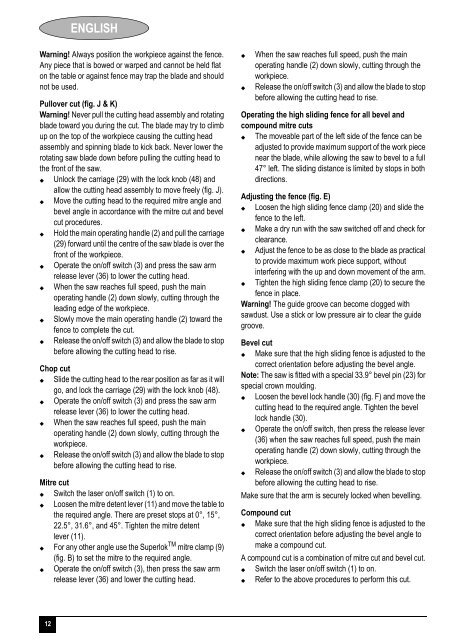BlackandDecker Scie A Onglets- Sms254 - Type 1 - Instruction Manual (Européen)
BlackandDecker Scie A Onglets- Sms254 - Type 1 - Instruction Manual (Européen)
BlackandDecker Scie A Onglets- Sms254 - Type 1 - Instruction Manual (Européen)
Create successful ePaper yourself
Turn your PDF publications into a flip-book with our unique Google optimized e-Paper software.
ENGLISH<br />
Warning! Always position the workpiece against the f<strong>en</strong>ce.<br />
Any piece that is bowed or warped and cannot be held flat<br />
on the table or against f<strong>en</strong>ce may trap the blade and should<br />
not be used.<br />
Pullover cut (fig. J & K)<br />
Warning! Never pull the cutting head assembly and rotating<br />
blade toward you during the cut. The blade may try to climb<br />
up on the top of the workpiece causing the cutting head<br />
assembly and spinning blade to kick back. Never lower the<br />
rotating saw blade down before pulling the cutting head to<br />
the front of the saw.<br />
Unlock the carriage (29) with the lock knob (48) and<br />
allow the cutting head assembly to move freely (fig. J).<br />
Move the cutting head to the required mitre angle and<br />
bevel angle in accordance with the mitre cut and bevel<br />
cut procedures.<br />
Hold the main operating handle (2) and pull the carriage<br />
(29) forward until the c<strong>en</strong>tre of the saw blade is over the<br />
front of the workpiece.<br />
Operate the on/off switch (3) and press the saw arm<br />
release lever (36) to lower the cutting head.<br />
Wh<strong>en</strong> the saw reaches full speed, push the main<br />
operating handle (2) down slowly, cutting through the<br />
leading edge of the workpiece.<br />
Slowly move the main operating handle (2) toward the<br />
f<strong>en</strong>ce to complete the cut.<br />
Release the on/off switch (3) and allow the blade to stop<br />
before allowing the cutting head to rise.<br />
Chop cut<br />
Slide the cutting head to the rear position as far as it will<br />
go, and lock the carriage (29) with the lock knob (48).<br />
Operate the on/off switch (3) and press the saw arm<br />
release lever (36) to lower the cutting head.<br />
Wh<strong>en</strong> the saw reaches full speed, push the main<br />
operating handle (2) down slowly, cutting through the<br />
workpiece.<br />
Release the on/off switch (3) and allow the blade to stop<br />
before allowing the cutting head to rise.<br />
Mitre cut<br />
Switch the laser on/off switch (1) to on.<br />
Loos<strong>en</strong> the mitre det<strong>en</strong>t lever (11) and move the table to<br />
the required angle. There are preset stops at 0°, 15°,<br />
22.5°, 31.6°, and 45°. Tight<strong>en</strong> the mitre det<strong>en</strong>t<br />
lever (11).<br />
For any other angle use the Superlok TM mitre clamp (9)<br />
(fig. B) to set the mitre to the required angle.<br />
Operate the on/off switch (3), th<strong>en</strong> press the saw arm<br />
release lever (36) and lower the cutting head.<br />
<br />
<br />
Wh<strong>en</strong> the saw reaches full speed, push the main<br />
operating handle (2) down slowly, cutting through the<br />
workpiece.<br />
Release the on/off switch (3) and allow the blade to stop<br />
before allowing the cutting head to rise.<br />
Operating the high sliding f<strong>en</strong>ce for all bevel and<br />
compound mitre cuts<br />
The moveable part of the left side of the f<strong>en</strong>ce can be<br />
adjusted to provide maximum support of the work piece<br />
near the blade, while allowing the saw to bevel to a full<br />
47° left. The sliding distance is limited by stops in both<br />
directions.<br />
Adjusting the f<strong>en</strong>ce (fig. E)<br />
Loos<strong>en</strong> the high sliding f<strong>en</strong>ce clamp (20) and slide the<br />
f<strong>en</strong>ce to the left.<br />
Make a dry run with the saw switched off and check for<br />
clearance.<br />
Adjust the f<strong>en</strong>ce to be as close to the blade as practical<br />
to provide maximum work piece support, without<br />
interfering with the up and down movem<strong>en</strong>t of the arm.<br />
Tight<strong>en</strong> the high sliding f<strong>en</strong>ce clamp (20) to secure the<br />
f<strong>en</strong>ce in place.<br />
Warning! The guide groove can become clogged with<br />
sawdust. Use a stick or low pressure air to clear the guide<br />
groove.<br />
Bevel cut<br />
Make sure that the high sliding f<strong>en</strong>ce is adjusted to the<br />
correct ori<strong>en</strong>tation before adjusting the bevel angle.<br />
Note: The saw is fitted with a special 33.9° bevel pin (23) for<br />
special crown moulding.<br />
Loos<strong>en</strong> the bevel lock handle (30) (fig. F) and move the<br />
cutting head to the required angle. Tight<strong>en</strong> the bevel<br />
lock handle (30).<br />
Operate the on/off switch, th<strong>en</strong> press the release lever<br />
(36) wh<strong>en</strong> the saw reaches full speed, push the main<br />
operating handle (2) down slowly, cutting through the<br />
workpiece.<br />
Release the on/off switch (3) and allow the blade to stop<br />
before allowing the cutting head to rise.<br />
Make sure that the arm is securely locked wh<strong>en</strong> bevelling.<br />
Compound cut<br />
Make sure that the high sliding f<strong>en</strong>ce is adjusted to the<br />
correct ori<strong>en</strong>tation before adjusting the bevel angle to<br />
make a compound cut.<br />
A compound cut is a combination of mitre cut and bevel cut.<br />
Switch the laser on/off switch (1) to on.<br />
Refer to the above procedures to perform this cut.<br />
12
















